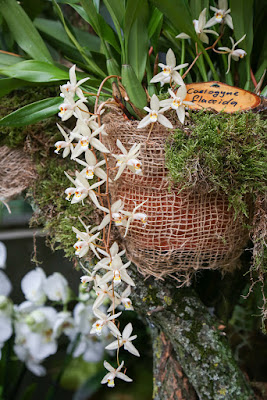Coelogyne flaccida is native to Nepal, Sikkim, Darjeeling District in West Bengal, Bhutan, Lushai Hills in Northeast India, Burma, Laos and Yunnan Province in southwestern China. In India, they grow in mixed forests at heights of 1000-1800 m...
Coelogyne flaccida also called as The Loose Coelogyne, Coelogyne esquirolii, Coelogyne flaccida var. longiracemosa, Coelogyne huettneriana, Pleione flaccida, is a species of the genus Coelogyne. This species was described by John Lindley in 1830.
IDENTIFY COELOGYNE FLACCIDA
Coelogyne flaccida is native to Nepal, Sikkim, Darjeeling District in West Bengal, Bhutan, Lushai Hills in Northeast India, Burma, Laos and Yunnan Province in southwestern China. In India, they grow in mixed forests at heights of 1000-1800 m. In south-west China they grow on trees and on rocks, at heights of 1600-1700 m.
It is a medium sized, warm to cool growing species, which reaching 42 cm in height, with close set, conical, lightly grooved, 5-12 cm high and 2.5 cm wide pseudobulbs carrying 2 apical, lanceolate, acuminate, plicate, 3 nerved, gradually narrowing below into the elongate, grooved, petiolate base, up to 30 cm long and 2-3 cm wide leaves.
The Loose Coelogyne produces basal, slender, pendulous 25 cm long, somewhat fractiflex rachis, loosely 5 to 12 flowered, racemose inflorescence arising on a mature pseudobulb with deciduous floral bracts and waxy, highly perfumed, cream colored, simultaneously opening flowers, each reaching about 4-5 cm across, occurring in the summer. The flowers are 3.5-4.0 cm in diameter and if they are kept in cool and shadow they can live long. The flower segments are white, but the lip is decorated with red stripes inside the side plots, with red dots at the base of the middle plot and golden-yellow in the center of the middle plot. The lip has 3 protuberances that are orange-brown at the vertices.
COELOGYNE FLACCIDA CARE AND CULTURE
Cultural information should only be used as a guide, and should be to be adapted to suit you. Your physical location; where you grow your plants, how much time you have to devote to their care, and many other factors, will need to be taken into account. Only then can you decide on the cultural methods that best suit you and your plants.
Light:
Coelogyne flaccida needs a light level of 18000-30000 lux. The light should be somewhat dispersed or filtered, avoid direct sunlight. Strong air movement should be ensured all the time.
Temperature:
The average temperature of the summer day is 24-25 ° C, the night 20-21 ° C, and the daily difference is 4-5 ° C. The average temperature of the winter day is 14-16 ° C, the night 8-9 ° C, giving a daily difference of 7 ° C.
Humidity:
In the summer and early autumn, The Loose Coelogyne needs the humidity of 90-95%, after which it drops to 80% at the end of autumn and at the beginning of winter. Over a period of one month at the end of winter or at the beginning of spring it falls to 75%.
Substrate, growing media:
Coelogyne flaccida grow well attached to pieces of tree fern or cork, but during the hot and clear summer days it requires high humidity and several waterings during the day. These plants are also planted into flat containers or baskets, using a loose, fast-drying substrate. Small or medium bark, tree fern fibers or mixtures with various additives such as charcoal, perlite, or cut sphagnum moss are often used as substrates.
You can grown in mesh baskets with 6 mm mesh, lined with coconut fiber or sphagnum moss. The substrate contains, in equal parts, fine and medium-sized tree fern fiber with the addition of 10% fine charcoal, 10% perlite or pumice, and 10% chopped sphagnum or moss. With a strong air movement, this mixture allows even shedding, because the substrate does not soak or dry completely between watering. Ferns of tree fern do not undergo too rapid decomposition, which means that it is not necessary to over-fertilize too often.
Repotting:
When the plant grows out of the basket, it can be completely repotted to a larger one without disturbing the roots. This is important because Coelogyne flaccida do not like repotting and after repotting or dividing can recover for 2-3 years.
It is recommended cutting old pseudobulbs instead of repotting, if the substrate is not very spread. If repotting is necessary, make sure that new roots are already beginning to grow. This allows the plant to rooting as quickly as possible.
Watering:
From the end of spring until autumn the rainfall is very abundant. Then the average rainfall drops sharply and the dry season begins, which lasts until the next spring. The Coelogyne flaccida should be abundantly watered during active growth, but the substrate around the roots must be perfectly aerated and can not be soggy or damp. When new growths reach maturity in autumn, the amount of water should be reduced.
Fertilizer:
Weekly use of 1/4-1/2 of the recommended dose of fertilizer for orchids during the growing season is recommended. You can use sustainable fertilizer throughout the growing season or use high-nitrogen fertilizer from spring to mid-summer, and then until the end of autumn, high phosphorus fertilizer.
The accumulation of mineral salts in the substrate may cause blackening of the tips of the leaves. Flowerpots should be washed regularly to prevent this, especially when high-mineralized water is used for watering.
Rest period:
A cool, dry rest is especially important for good condition and flowering. Over the period of 4-5 winter months, the amount of water in winter should be reduced, but should not be completely eliminated. Coelogyne flaccida should dry a little between waterings, but they can not stay dry for too long. Fertilization should be reduced or eliminated until new growths appear in spring and regular watering starts.














COMMENTS